2018心肺复苏CPR流程--英文版
cpr心肺复苏急救操作流程
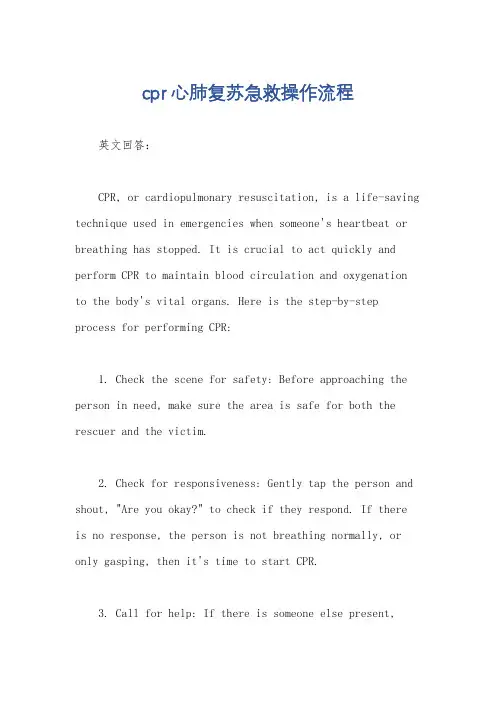
cpr心肺复苏急救操作流程英文回答:CPR, or cardiopulmonary resuscitation, is a life-saving technique used in emergencies when someone's heartbeat or breathing has stopped. It is crucial to act quickly and perform CPR to maintain blood circulation and oxygenation to the body's vital organs. Here is the step-by-step process for performing CPR:1. Check the scene for safety: Before approaching the person in need, make sure the area is safe for both the rescuer and the victim.2. Check for responsiveness: Gently tap the person and shout, "Are you okay?" to check if they respond. If thereis no response, the person is not breathing normally, or only gasping, then it's time to start CPR.3. Call for help: If there is someone else present,instruct them to call emergency services (911 or the local emergency number) and retrieve an AED (automated external defibrillator) if available.4. Open the airway: Tilt the person's head backslightly and lift the chin to open the airway.5. Check for breathing: Look, listen, and feel for breathing. Place your ear near the person's mouth and nose, look for chest rise and fall, and feel for breath on your cheek. If the person is not breathing normally, it's time to start CPR.6. Perform chest compressions: Kneel beside the person and place the heel of one hand on the center of the chest, then place the other hand on top. Push hard and fast, aiming for a rate of 100-120 compressions per minute. Allow the chest to fully recoil between compressions.7. Give rescue breaths: Tilt the person's head back, pinch the nose, and give two breaths into the mouth, watching for chest rise with each breath.8. Continue cycles of compressions and breaths: Perform 30 chest compressions followed by two rescue breaths. Continue this cycle until help arrives or the person shows signs of life.9. Use an AED if available: If an AED arrives, turn it on and follow the prompts for its use.10. Continue until help arrives: Keep performing CPR until emergency medical services take over or the person shows signs of life.中文回答:CPR,即心肺复苏,是一种在紧急情况下使用的救生技术,当有人的心跳或呼吸停止时使用。
最新心肺复苏CPR流程--英文版
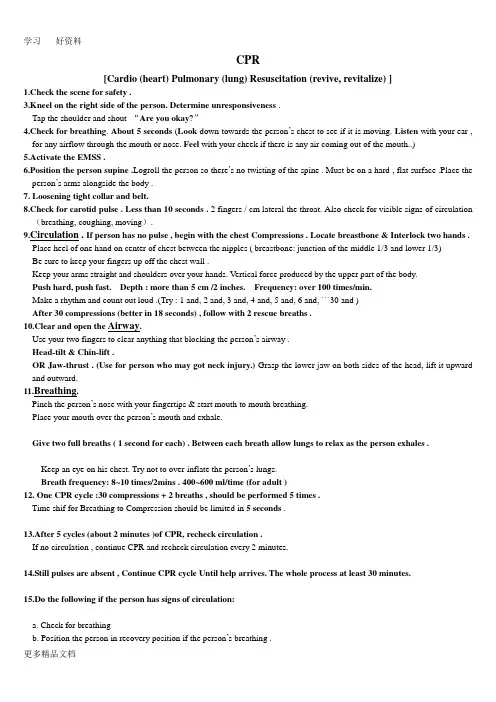
CPR[Cardio (heart) Pulmonary (lung) Resuscitation (revive, revitalize) ]1.Check the scene for safety .3.Kneel on the right side of the person. Determine unresponsiveness .Tap the shoulder and shout “Are you okay?”4.Check for breathing. About 5 seconds (Look down towards the person’s chest to see if it is moving. Listen with your ear , for any airflow through the mouth or nose. Feel with your cheek if there is any air coming out of the mouth..)5.Activate the EMSS .6.Position the person supine .Logroll the person so there’s no twisting of the spine . Must be on a hard , flat surface .Place the person’s arms alongside the body .7. Loosening tight collar and belt.8.Check for carotid pulse .Less than 10 seconds . 2 fingers / cm lateral the throat. Also check for visible signs of circulation (breathing, coughing, moving).9.Circulation . If person has no pulse , begin with the chest Compressions . Locate breastbone & Interlock two hands . Place heel of one hand on center of chest between the nipples ( breastbone: junction of the middle 1/3 and lower 1/3)Be sure to keep your fingers up off the chest wall .Keep your arms straight and shoulders over your hands. Vertical force produced by the upper part of the body.Push hard, push fast. Depth : more than 5 cm /2 inches. Frequency: over 100 times/min.Make a rhythm and count out loud .(Try : 1 and, 2 and, 3 and, 4 and, 5 and, 6 and, ```30 and )After 30 compressions (better in 18 seconds) , follow with 2 rescue breaths .10.Clear and open the Airway.Use your two fingers to clear anything that blocking the person’s airway .Head-tilt & Chin-lift .OR Jaw-thrust . (Use for person who may got neck injury.) Grasp the lower jaw on both sides of the head, lift it upward and outward.11.Breathing.Pinch the person’s nose with your fingertips & start mouth to mouth breathing.Place your mouth over the person’s mouth and exhale.Give two full breaths ( 1 second for each) . Between each breath allow lungs to relax as the person exhales .Keep an eye on his chest. Try not to over-inflate the person’s lungs.Breath frequency: 8~10 times/2mins . 400~600 ml/time (for adult )12. One CPR cycle :30 compressions + 2 breaths , should be performed 5 times .Time shif for Breathing to Compression should be limited in 5 seconds .13.After 5 cycles (about 2 minutes )of CPR, recheck circulation .If no circulation , continue CPR and recheck circulation every 2 minutes.14.Still pulses are absent , Continue CPR cycle Until help arrives. The whole process at least 30 minutes.15.Do the following if the person has signs of circulation:a. Check for breathingb. Position the person in recovery position if the person’s breathing .c. Monitor breathing and circulation .d. Record the process.16.Do the following if the person has signs of circulation but breathing is absent:a. Give 1 rescue breath every 5 seconds .b. Monitor circulation ..。
心肺复苏流程英文版
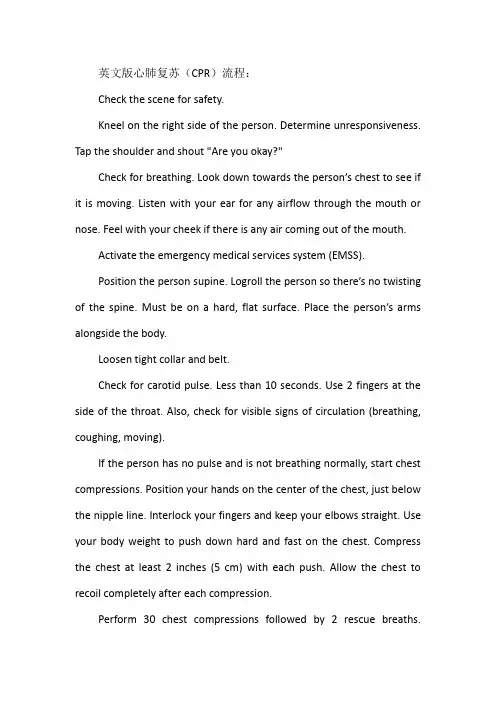
英文版心肺复苏(CPR)流程:Check the scene for safety.Kneel on the right side of the person. Determine unresponsiveness. Tap the shoulder and shout "Are you okay?"Check for breathing. Look down towards the person’s chest to see if it is moving. Listen with your ear for any airflow through the mouth or nose. Feel with your cheek if there is any air coming out of the mouth.Activate the emergency medical services system (EMSS).Position the person supine. Logroll the person so there’s no twisting of the spine. Must be on a hard, flat surface. Place the person’s arms alongside the body.Loosen tight collar and belt.Check for carotid pulse. Less than 10 seconds. Use 2 fingers at the side of the throat. Also, check for visible signs of circulation (breathing, coughing, moving).If the person has no pulse and is not breathing normally, start chest compressions. Position your hands on the center of the chest, just below the nipple line. Interlock your fingers and keep your elbows straight. Use your body weight to push down hard and fast on the chest. Compress the chest at least 2 inches (5 cm) with each push. Allow the chest to recoil completely after each compression.Perform 30 chest compressions followed by 2 rescue breaths.Continue this cycle until professional help arrives or the person recovers.中文版心肺复苏(CPR)流程:首先检查现场是否安全。
2018心肺复苏CPR流程--英文版
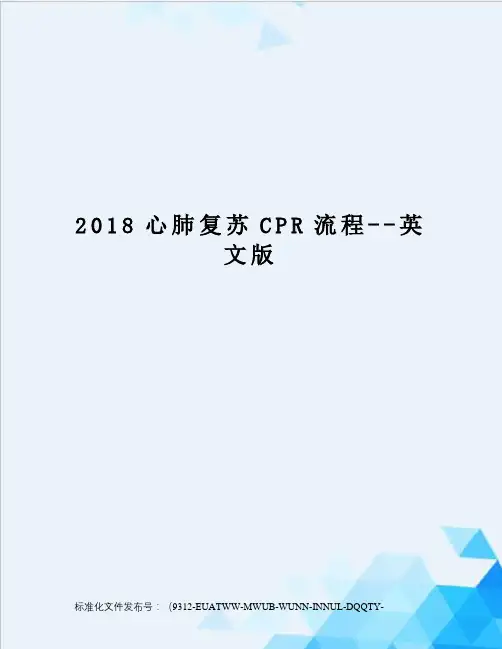
2018心肺复苏C P R流程--英文版标准化文件发布号:(9312-EUATWW-MWUB-WUNN-INNUL-DQQTY-CPR[Cardio (heart) Pulmonary (lung) Resuscitation (revive, revitalize) ]the scene for safety .on the right side of the person. Determine unresponsiveness .Tap the shoulder and shout “Are you okay”for breathing. About 5 seconds (Look down towards the person’s chest to see if it is moving. Listen with your ear , for any airflow through the mouth or nose. Feel with your cheek if there is any air coming out of the mouth..)the EMSS .the person supine .Logroll the person so there’s no twisting of the spine . Must be on a hard , flatsurface .Place the person’s arms alongside the body .7. Loosening tight collar and belt.for carotid pulse .Less than 10 seconds . 2 fingers / cm lateral the throat. Also check for visible signs of circulation(breathing, coughing, moving).. If person has no pulse , begin with the chest Compressions . Locate breastbone & Interlock two hands . Place heel of one hand on center of chest between the nipples ( breastbone: junction of the middle 1/3 and lower 1/3)Be sure to keep your fingers up off the chest wall .Keep your arms straight and shoulders over your hands. Vertical force produced by the upper part of the body.Push hard, push fast. Depth : more than 5 cm /2 inches. Frequency: over 100 times/min.Make a rhythm and count out loud .(Try : 1 and, 2 and, 3 and, 4 and, 5 and, 6 and, ```30 and )After 30 compressions (better in 18 seconds) , follow with 2 rescue breaths .and open the Airway.Use your two fingers to clear anything that blocking the person’s airway .Head-tilt & Chin-lift .OR Jaw-thrust . (Use for person who may got neck injury.) Grasp the lower jaw on both sides of the head, lift it upward and outward..Pinch the person’s nose with your fingertips & start mouth to mouth breathing.Place your mouth over the person’s mouth and exhale.Give two full breaths ( 1 second for each) . Between each breath allow lungs to relax as the person exhales . Keep an eye on his chest. Try not to over-inflate the person’s lungs.Breath frequency: 8~10 times/2mins . 400~600 ml/time (for adult )12. One CPR cycle :30 compressions + 2 breaths , should be performed 5 times .Time shif for Breathing to Compression should be limited in 5 seconds .5 cycles (about 2 minutes )of CPR, recheck circulation .If no circulation , continue CPR and recheck circulation every 2 minutes.pulses are absent , Continue CPR cycle Until help arrives. The whole process at least 30 minutes.the following if the person has signs of circulation:a. Check for breathingb. Position the person in recovery position if the person’s breathing .c. Monitor breathing and circulation .d. Record the process.the following if the person has signs of circulation but breathing is absent:a. Give 1 rescue breath every 5 seconds .b. Monitor circulation ..。
CPR流程--英文版
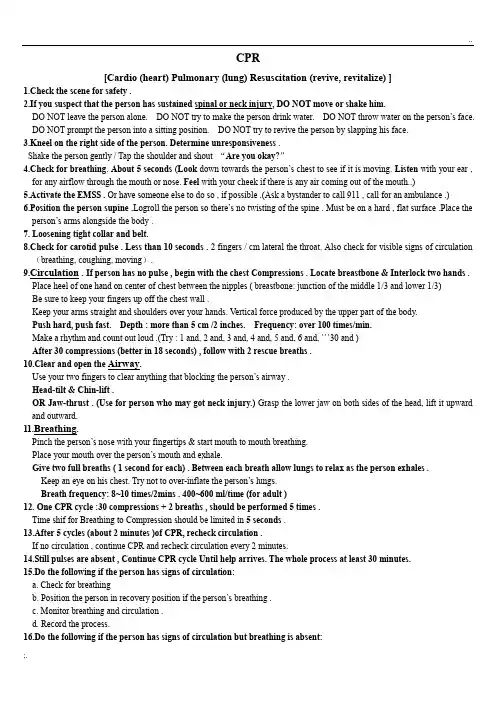
CPR[Cardio (heart) Pulmonary (lung) Resuscitation (revive, revitalize) ]1.Check the scene for safety .2.If you suspect that the person has sustained spinal or neck injury, DO NOT move or shake him.DO NOT leave the person alone. DO NOT try to make the person drink water. DO NOT throw water on the person’s face. DO NOT prompt the person into a sitting position. DO NOT try to revive the person by slapping his face.3.Kneel on the right side of the person. Determine unresponsiveness .Shake the person gently / Tap the shoulder and shout “Are you okay?”4.Check for breathing. About 5 seconds (Look down towards the person’s chest to see if it is moving. Listen with your ear , for any airflow through the mouth or nose. Feel with your cheek if there is any air coming out of the mouth..)5.Activate the EMSS . Or have someone else to do so , if possible .(Ask a bystander to call 911 , call for an ambulance .)6.Position the person supine .Logroll the person so there’s no twisting of the spine . Must be on a hard , flat surface .Place the person’s arms alongside the body .7. Loosening tight collar and belt.8.Check for carotid pulse .Less than 10 seconds . 2 fingers / cm lateral the throat. Also check for visible signs of circulation (breathing, coughing, moving).9.Circulation . If person has no pulse , begin with the chest Compressions . Locate breastbone & Interlock two hands . Place heel of one hand on center of chest between the nipples ( breastbone: junction of the middle 1/3 and lower 1/3)Be sure to keep your fingers up off the chest wall .Keep your arms straight and shoulders over your hands. Vertical force produced by the upper part of the body.Push hard, push fast. Depth : more than 5 cm /2 inches. Frequency: over 100 times/min.Make a rhythm and count out loud .(Try : 1 and, 2 and, 3 and, 4 and, 5 and, 6 and, ```30 and )After 30 compressions (better in 18 seconds) , follow with 2 rescue breaths .10.Clear and open the Airway.Use your two fingers to clear anything that blocking the person’s airway .Head-tilt & Chin-lift .OR Jaw-thrust . (Use for person who may got neck injury.) Grasp the lower jaw on both sides of the head, lift it upward and outward.11.Breathing.Pinch the person’s nose with your fingertips & start mouth to mouth breathing.Place your mouth over the person’s mouth and exhale.Give two full breaths ( 1 second for each) . Between each breath allow lungs to relax as the person exhales .Keep an eye on his chest. Try not to over-inflate the person’s lungs.Breath frequency: 8~10 times/2mins . 400~600 ml/time (for adult )12. One CPR cycle :30 compressions + 2 breaths , should be performed 5 times .Time shif for Breathing to Compression should be limited in 5 seconds .13.After 5 cycles (about 2 minutes )of CPR, recheck circulation .If no circulation , continue CPR and recheck circulation every 2 minutes.14.Still pulses are absent , Continue CPR cycle Until help arrives. The whole process at least 30 minutes.15.Do the following if the person has signs of circulation:a. Check for breathingb. Position the person in recovery position if the person’s breathing .c. Monitor breathing and circulation .d. Record the process.16.Do the following if the person has signs of circulation but breathing is absent:a. Give 1 rescue breath every 5 seconds .b. Monitor circulation ..。
cpr心肺复苏国际标准操作流程
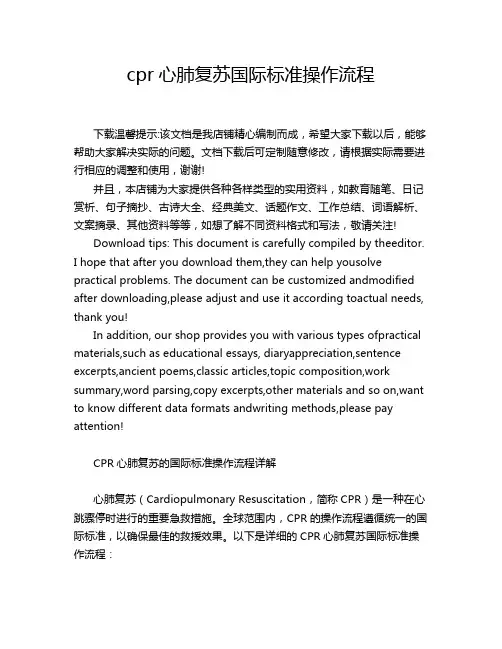
cpr心肺复苏国际标准操作流程下载温馨提示:该文档是我店铺精心编制而成,希望大家下载以后,能够帮助大家解决实际的问题。
文档下载后可定制随意修改,请根据实际需要进行相应的调整和使用,谢谢!并且,本店铺为大家提供各种各样类型的实用资料,如教育随笔、日记赏析、句子摘抄、古诗大全、经典美文、话题作文、工作总结、词语解析、文案摘录、其他资料等等,如想了解不同资料格式和写法,敬请关注!Download tips: This document is carefully compiled by theeditor.I hope that after you download them,they can help yousolve practical problems. The document can be customized andmodified after downloading,please adjust and use it according toactual needs, thank you!In addition, our shop provides you with various types ofpractical materials,such as educational essays, diaryappreciation,sentence excerpts,ancient poems,classic articles,topic composition,work summary,word parsing,copy excerpts,other materials and so on,want to know different data formats andwriting methods,please pay attention!CPR心肺复苏的国际标准操作流程详解心肺复苏(Cardiopulmonary Resuscitation,简称CPR)是一种在心跳骤停时进行的重要急救措施。
CPR步骤英文版
How to perform Hands-Only CPRCardiac emergency can happen prepared the simple technique,know the Hands-Only CPR,you can learn it only 5 minute,it’s easy to remember and it can help save a life.Step 1:If you see someone suddenly on the place,Check the safety of the entironment,and Put the person on his/her back on a firm next to the person’s neck and the person response you by tapping on the shoulder and shouting:Are you OKIf they don’t respond,call or send someone to call 120,or look around the emergency number right away.Step 2:Check the pulse and breath at 5-10 seconds(count …..1007),Use the index and middle fingers to check the pulse of carotid your face near the person’s mouth and look for the chest motion at the same time. If the person isn’t breathing normally and have no caroid pulse , perpare to give chest compression. And you must start the emergency response system,such as phone 120、catch AED (automatic external difibrillator).Step 3:Place the heel of one hand over the center of the person’s chest, between the nipples. Place your other hand on top of the first hand. Keep your elbows straight and position your shoulders directly above your hands.Use your upper body weights as you push straight down on the chest at a depth of at least 5-6 cm. Push hard at a rate of about 100 -120 compressions a minute.Step 4:Open the person’s airway.Put your palm on the person’s forehead and gently tilt the head the other hand, gently lift the chin forward to open the airway.With the airway open, pinch the nostrils shut for mouth-to-mouth(mouth-to-mask) breathing and cover the person’s mouth with yours, making a seal.(make sure there is no leakage)。
cp r心肺复苏国际标准操作流程
cp r心肺复苏国际标准操作流程下载温馨提示:该文档是我店铺精心编制而成,希望大家下载以后,能够帮助大家解决实际的问题。
文档下载后可定制随意修改,请根据实际需要进行相应的调整和使用,谢谢!并且,本店铺为大家提供各种各样类型的实用资料,如教育随笔、日记赏析、句子摘抄、古诗大全、经典美文、话题作文、工作总结、词语解析、文案摘录、其他资料等等,如想了解不同资料格式和写法,敬请关注!Download tips: This document is carefully compiled by theeditor.I hope that after you download them,they can help yousolve practical problems. The document can be customized andmodified after downloading,please adjust and use it according toactual needs, thank you!In addition, our shop provides you with various types ofpractical materials,such as educational essays, diaryappreciation,sentence excerpts,ancient poems,classic articles,topic composition,work summary,word parsing,copy excerpts,other materials and so on,want to know different data formats andwriting methods,please pay attention!CP R心肺复苏:国际标准操作流程详解心肺复苏(CPR)是一种紧急医疗技术,用于恢复心跳和呼吸停止的患者的生命。
急救措施心肺复苏操作流程
急救措施心肺复苏操作流程英文回答:Cardiopulmonary Resuscitation (CPR) Procedure.CPR is an emergency lifesaving procedure that combines chest compressions and rescue breathing to keep oxygen flowing to the brain and other vital organs during a cardiac arrest.Steps of CPR:1. Check for Responsiveness:Tap the person's shoulder and shout, "Are you okay?"If no response, call for emergency medical services (EMS) immediately.2. Position the Person:Place the person on a firm, flat surface.3. Open the Airway:Tilt the person's head back slightly and lift their chin.4. Check for Breathing:Look, listen, and feel for breathing for up to 10 seconds.5. If Not Breathing, Begin Chest Compressions:Place the heel of one hand on the center of the person's chest, between the nipples.Place the heel of your other hand on top of thefirst hand and interlace your fingers.Position your shoulders directly above your handsand keep your elbows straight.Push down hard and fast, at a rate of 100-120 compressions per minute.Allow the chest to recoil fully after each compression.6. Give Rescue Breaths (After Every 30 Compressions):Pinch the person's nose shut.Take a normal breath and seal your mouth over the person's mouth.Give two rescue breaths, each lasting about 1 second.Check for chest rise after each breath.7. Continue CPR:Perform 30 compressions followed by 2 rescue breathsuntil:EMS arrives.The person shows signs of life.You become too exhausted to continue.Additional Notes:Use an automated external defibrillator (AED) if one is available.If you are not comfortable giving rescue breaths, perform hands-only CPR (chest compressions only).CPR is a complex skill and should be learned from a certified instructor.中文回答:心肺复苏术 (CPR) 操作流程。
CPR步骤英文版.doc
CardiacHow to perform Hands-Only CPRemergency can happen prepared the simple technique,know the Hands-OnlyCPR,you can learn it only 5 minute,itlife.’ s easy to remember and it can help save a Step 1:If you see someone suddenly on the place,Check the safety of the entironment,and Put the person on his/her back on a firm next to the person ’ s neck and the person response you by tapping on the shoulder and shouting:Are you OKIf they don’ t respond,call or send someone to call 120,or look around theemergency number right away.Step 2:Check the pulse and breath at 5-10 seconds(countUse the index and middle fingers to check the pulse of carotid⋯ ..1007), your face near theperson ’ s mouth and look for the chest motion at the same time. If the person isn ’t breathing normally and have no caroid pulse ,perpare to give chest compression. And you must start the emergency response system,such as phone 120 、 catch AED (automatic external difibrillatorStep 3:) .Place the heel of one hand over the center nipples. Place your other hand on top of the first of thehand.person ’ s chest, between theKeep your elbows straightand position your shoulders directly above your hands.Use your upper body weights as you push straight down on the chest at a depth of at least 5-6 cm. Push hard at a rate of about 100 -120 compressions a minute.Step 4:Open the person’ s airway.Put your palm on the person’s forehead and gently tilt the head the other hand, gently lift the chin forward to open the airway.With the airway open, pinch the nostrils shut for mouth-to-mouth(mouth-to-mask) breathing and cover the person ’ s mouth with yours, making a seal.(make sure there is no leakage) 。
- 1、下载文档前请自行甄别文档内容的完整性,平台不提供额外的编辑、内容补充、找答案等附加服务。
- 2、"仅部分预览"的文档,不可在线预览部分如存在完整性等问题,可反馈申请退款(可完整预览的文档不适用该条件!)。
- 3、如文档侵犯您的权益,请联系客服反馈,我们会尽快为您处理(人工客服工作时间:9:00-18:30)。
CPR
[Cardio (heart) Pulmonary (lung) Resuscitation (revive, revitalize) ]
1.Check the scene for safety .
3.Kneel on the right side of the person. Determine unresponsiveness .
Tap the shoulder and shout “Are you okay?”
4.Check for breathing. About 5 seconds (Look down towards the person’s chest to see if it is moving. Listen with your ear , for any airflow through the mouth or nose. Feel with your cheek if there is any air coming out of the mouth..)
5.Activate the EMSS .
6.Position the person supine .Logroll the person so there’s no twisting of the spine . Must be on a hard , flat surface .Place the person’s arms alongside the body .
7. Loosening tight collar and belt.
8.Check for carotid pulse .Less than 10 seconds . 2 fingers / cm lateral the throat. Also check for visible signs of circulation (breathing, coughing, moving).
9.Circulation . If person has no pulse , begin with the chest Compressions . Locate breastbone & Interlock two hands . Place heel of one hand on center of chest between the nipples ( breastbone: junction of the middle 1/3 and lower 1/3)
Be sure to keep your fingers up off the chest wall .
Keep your arms straight and shoulders over your hands. Vertical force produced by the upper part of the body.
Push hard, push fast. Depth : more than 5 cm /2 inches. Frequency: over 100 times/min.
Make a rhythm and count out loud .(Try : 1 and, 2 and, 3 and, 4 and, 5 and, 6 and, ```30 and )
After 30 compressions (better in 18 seconds) , follow with 2 rescue breaths .
10.Clear and open the Airway.
Use your two fingers to clear anything that blocking the person’s airway .
Head-tilt & Chin-lift .
OR Jaw-thrust . (Use for person who may got neck injury.) Grasp the lower jaw on both sides of the head, lift it upward and outward.
11.Breathing.
Pinch the person’s nose with your fingertips & start mouth to mouth breathing.
Place your mouth over the person’s mouth and exhale.
Give two full breaths ( 1 second for each) . Between each breath allow lungs to relax as the person exhales .
Keep an eye on his chest. Try not to over-inflate the person’s lungs.
Breath frequency: 8~10 times/2mins . 400~600 ml/time (for adult )
12. One CPR cycle :30 compressions + 2 breaths , should be performed 5 times .
Time shif for Breathing to Compression should be limited in 5 seconds .
13.After 5 cycles (about 2 minutes )of CPR, recheck circulation .
If no circulation , continue CPR and recheck circulation every 2 minutes.
14.Still pulses are absent , Continue CPR cycle Until help arrives. The whole process at least 30 minutes.
15.Do the following if the person has signs of circulation:
a. Check for breathing
b. Position the person in recovery position if the person’s breathing .
c. Monitor breathing and circulation .
d. Record the process.
16.Do the following if the person has signs of circulation but breathing is absent:
a. Give 1 rescue breath every 5 seconds .
b. Monitor circulation .
.。
